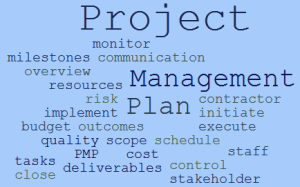 You landed on a great project team and were asked to prepare the Project Management Plan. Even though you’ve executed or implemented project management plans, you never actually prepared a project management plan. Where do you start? What elements belong in the project management plan?
You landed on a great project team and were asked to prepare the Project Management Plan. Even though you’ve executed or implemented project management plans, you never actually prepared a project management plan. Where do you start? What elements belong in the project management plan?
Let’s start with some basics.
Is a “project management plan” the same as a “project plan” or a “project schedule?” It depends on who you ask, but generally, no. Google search the terms and you’ll find similarities and differences opined, even among some certified project manager practitioners. Sometimes the terms are used interchangeably in an organization, or they could be very different documents. That’s OK. What’s important is to understand what your organization or agency expect from the plan. For the sake of this article, we’ll use the term “project management plan” (PMP for short) and define its meaning and address its elements.
The Project Management Institute, Inc.’s (PMI), A Guide to the Project Management Body of Knowledge (PMBOK), identifies a project management plan as a formal, approved document that defines how the project is executed, monitored and controlled, and closed. The content of the PMP will vary depending on the project, and could be complex and detailed, or it could be a summary of the project plan details and other planning documents. Best practice is that large, complex projects will involve a detailed and complex PMP, because the project typically involves critical, high risk, or many interdependent tasks. (Think constructing a new building or bridge, developing a military aircraft, or replacing an organization’s entire Information Technology infrastructure.) As projects are implemented, plans can shift and change due to unforeseen circumstances or other situations that impact the project. PMPs should therefore, be considered a living document that requires updating throughout the life of the project.
Why is a project management plan necessary?
Projects can begin and end without a formal PMP, but the project runs the risk of compromising the desired result. PMPs assist government and contractor project teams to manage, execute, and deliver a project’s activities and tasks so that the expected project goals are achieved. Anyone who has ever been involved in a project without buy-in from all stakeholders, a clear understanding of the project and its expected outcome, the prescription for how to manage and control its varied tasks and risks, or how to orchestrate the project’s resources, has seen a project fail in at least one of three areas: cost, time (schedule), or quality. Well-developed PMPs take time to come together, but the effort greatly increases the likelihood of successful project completion within budget, on-time, and with a high degree of quality.
What elements belong in a PMP?
Project management consists of a set of phased processes to which a project manager applies their “knowledge, skills, and techniques to execute projects effectively and efficiently (PMI.org).” PMI’s PMBOK outlines these five processes as: Initiating, Planning, Executing, Monitoring and Controlling, and Closing. PMPs will incorporate details or a summary describing how the project will be managed considering each of these process phases. The complexity of the project should dictate the content and format of the PMP. For simple, non-complex projects, the PMP would likely summarize content in the various phases and could consist of only a few pages (it doesn’t have to be lengthy); whereas a complex project would consist of detailed project information and supplemental planning documents that detail how the project will be initiated, planned, executed, monitored, controlled, and closed.
Below is a general list of the various management plans that at a minimum should always be included in PMPs. Items can be summarized or logically grouped for a simple, non-complex project, but each management plan should be separately detailed for complex projects. Management plans will describe the relative who, what, where, and when of that particular management area (e.g., risk, schedule, cost, etc.).
Project Overview (Project Introduction): Think of this as an executive summary that describes the project, who is involved, when the project will be completed, and where the project is located. It can also include the budget and project duration.
Scope Management: Describes the scope of the work required to complete the project. It can include a Work Breakdown Structure. A good scope management plan helps manage scope creep.
Schedule/Time Management: Includes milestones, project schedules, and project deliverables. This plan is vital to managing the progress of the project, and identifying successful completion or slippage of milestones and overall project schedule.
Cost/Budget Management: Describes how the project budget and cost variances will be managed so the project is completed within budget. This plan is vital to ensuring costs are accurately accounted for and that there are no cost overruns due to mismanagement.
Quality Management: Describes how the project/product quality will be managed. It can include matrices, and quality surveillance plans. This plan is vital to ensuring a quality product or service is delivered.
Staff Management (Human Resource Management): Describes the staffing plan, key personnel and stakeholders, and how resources will be managed throughout the project or product development.
Communication Management/Plan: Describes how communication will flow between project teams and stakeholders, including types of communication acceptable. This plan can include acceptable formats of communications, and identify individuals to whom situations can be elevated.
Risk Management: Describes how risks will be assessed, monitored, responded to, and will describe how any risks will be reported and to whom. For risk management, be aware of and differentiate between risks and issues, but focus on risks.
A Project Management Plan is a living document that helps keep participants informed and on-track so they can guide a project to successful completion. What other vital elements do you include in your PMPs?

